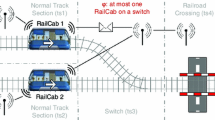Abstract
Modern automobile embedded systems form highly complex distributed networks of electronic control units (ECUs). Model-based development is a widespread approach to tackle this complexity. AutoFocus is a CASE tool prototype aiming at formally sound model-based development of embedded systems. A model is hierarchically composed of components that communicate over typed channels. AutoFocus has a robust and plain formal semantics: communication and execution are synchronised by a global clock for all components. In this article we present an extension of the AutoFocus semantics allowing time refinement of components. It enables a simpler modularisation of systems, a better structuring of behaviour specifications, and a better mapping to the target platform of real embedded systems. At the same time, it maintains the advantages of fixed clocking of the AutoFocus semantics, such as strong causality and guaranteed termination of computation steps.
Similar content being viewed by others
References
SCADE Suite. http://www.esterel-technologies.com/products/scade-suite/
The ASCET Product Family. http://www.etas.com/en/products/ascet_software_products.php
Angermann A, Beuschel M, Rau M (2005) Matlab–simulink–stateflow. Oldenbourg, Munich
von der Beeck M (1994) A comparison of statecharts variants. In: Langmaack H, de Roever WP, Vytopil J (eds) Formal techniques in real-time and fault-tolerant systems (FTRTFT ’94), Third international symposium organized jointly with the working group provably correct systems—ProCoS, proceedings. Lecture notes in computer science, vol 863. Springer, Berlin, pp 128–148
Broy M (2009) Relating time and causality in interactive distributed systems. In: Broy M, Sitou W, Hoare T (eds) Engineering methods and tools for software safety and security. Proceedings of the NATO advanced study institute on engineering methods and tools for software safety and security, Marktoberdorf, Germany, 5–17 August 2008. NATO science for peace and security series—D: Information and communication security, vol 22. IOS Press, Amsterdam
Broy M, Stølen K (2001) Specification and development of interactive systems: focus on streams, interfaces, and refinement. Springer, Berlin
Caspi P, Pilaud D, Halbwachs N, Plaice J (1987) LUSTRE: a declarative language for programming synchronous systems. In: POPL ’87: proceedings of the 14th ACM SIGACT-SIGPLAN symposium on principles of programming languages. ACM, New York, pp 178–188
Frischkorn HG (2003) IT im Automobil – Innovationsfeld der Zukunft (IT in Automobiles—Innovation Field of the Future). Invited Workshop Keynote, Automotive Software Engineering and Concepts, INFORMATIK 2003. In: 33. Jahrestagung der Gesellschaft für Informatik e.V. (GI) (33rd Annual Meeting of the Society for Computer Science (registered association))
Grimm K (2003) Software technology in an automotive company—major challenges. IEEE Comput Soc, Los Alamitos, pp 498–505
Guernic PL, Talpin JP, Lann JCL (2003) POLYCHRONY for system design. J Circuits Syst Comput 12(3):261–304
Harel D (1987) Statecharts: A visual formalism for complex systems. Sci Comput Program 8(3):231–274
Harel D, Kugler H (2004) The Rhapsody semantics of statecharts (or, on the executable core of the UML)—preliminary version. In: Ehrig H, Damm W, Desel J, Große-Rhode M, Reif W, Schnieder E, Westkämper E (eds) SoftSpez final report: integration of software specification techniques for applications in engineering, priority program SoftSpez of the German research foundation (DFG), Final report. Lecture notes in computer science, vol 3147. Springer, Berlin, pp 325–354
Hertel G (2006) Mercer-Studie Autoelektronik—Elektronik setzt die Impulse im Auto (Mercer study car electronics—electronics sets impulses in the car). http://www.oliverwyman.com/de/pdf-files/ManSum_Elektronikstudiedig.pdf
Huber F, Schätz B, Einert G (1997) Consistent graphical specification of distributed systems. In: Fitzgerald J, Jones CB, Lucas P (eds) FME ’97: industrial applications and strengthened foundations of formal methods, 4th international symposium of formal methods Europe, proceedings. Lecture notes in computer science, vol 1313. Springer, Berlin, pp 122–141
Huber F, Schätz B, Schmidt A, Spies K (1996) AutoFocus—a tool for distributed systems specification. In: Jonsson B, Parrow J (eds) Formal techniques in real-time and fault-tolerant systems, 4th international symposium, FTRTFT’96, proceedings. Lecture notes in computer science, vol 1135. Springer, Berlin, pp 467–470
Pretschner A, Broy M, Krüger IH, Stauner T (2007) Software engineering for automotive systems: a roadmap. In: FOSE 2007: 29th international conference on software engineering (ICSE 2007), future of software engineering. IEEE Comput Soc, Los Alamitos, pp 55–71
Reinfrank M (2006) Why is automotive software so valuable?: or 5000 lines of code for a cup of gasoline less (Keynote Talk). In: SEAS 2006: proceedings of the 3rd international ICSE workshop on software engineering for automotive systems. ACM, New York, pp 3–4
Scaife N, Sofronis C, Caspi P, Tripakis S, Maraninchi F (2004) Defining and translating a “safe” subset of simulink/stateflow into Lustre. In: Buttazzo GC (ed) EMSOFT 2004, proceedings of the 4th ACM international conference on embedded software. ACM, New York, pp 259–268
Shiple TR, Berry G, Touati H (1996) Constructive analysis of cyclic circuits. In: EDTC 1996: Proceedings of the 1996 European conference on design and test. IEEE Comput Soc, Los Alamitos, p 328
Trachtenherz D (2011) AutoFocus streams processing for single-clocking and multi-clocking semantics. In: Klein G, Nipkow T, Paulson L (eds) The archive of formal proofs. http://afp.sourceforge.net/entries/AutoFocus-Stream.shtml. ISSN 2150-914x
Trachtenherz D (2009) Ausführungssemantik von AutoFocus-Modellen: Isabelle/HOL/Formalisierung und Äquivalenzbeweis (Execution semantics of autofocus models: Isabelle/HOL formalisation and equivalence proof). Technical Report TUM-I0903, Institut für Informatik, Technische Universität München
Trachtenherz D (2009) Eigenschaftsorientierte Beschreibung der logischen Architektur eingebetteter Systeme (Property-oriented description of logical architecture of embedded systems). Ph.D. thesis, Institut für Informatik Technische Universität München
Author information
Authors and Affiliations
Corresponding author
Rights and permissions
About this article
Cite this article
Trachtenherz, D. Formal semantics of modular time refinement in AutoFocus . Comput Sci Res Dev 28, 45–64 (2013). https://doi.org/10.1007/s00450-011-0148-2
Published:
Issue Date:
DOI: https://doi.org/10.1007/s00450-011-0148-2




